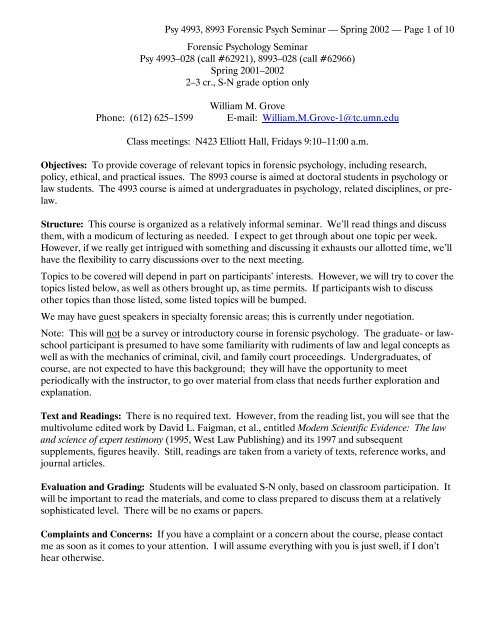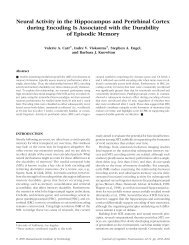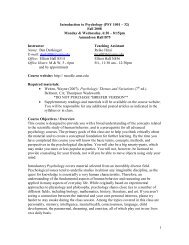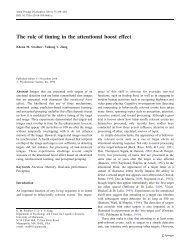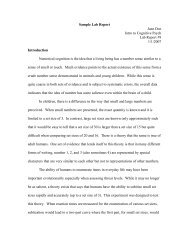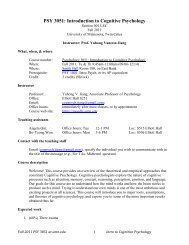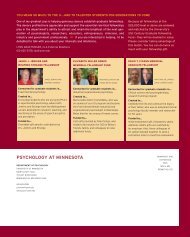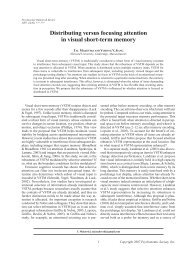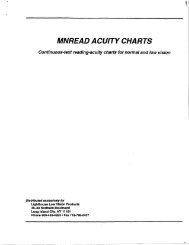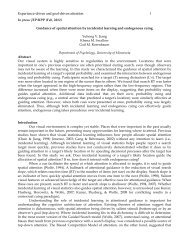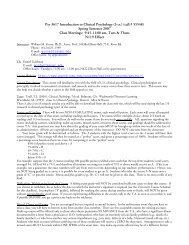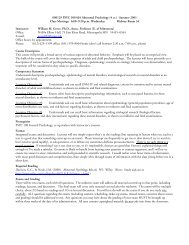Psy 4993, 8993 Forensic Psychology Seminar - University of ...
Psy 4993, 8993 Forensic Psychology Seminar - University of ...
Psy 4993, 8993 Forensic Psychology Seminar - University of ...
Create successful ePaper yourself
Turn your PDF publications into a flip-book with our unique Google optimized e-Paper software.
<strong>Psy</strong> <strong>4993</strong>, <strong>8993</strong> <strong>Forensic</strong> <strong>Psy</strong>ch <strong>Seminar</strong> — Spring 2002 — Page 1 <strong>of</strong> 10<br />
<strong>Forensic</strong> <strong>Psy</strong>chology <strong>Seminar</strong><br />
<strong>Psy</strong> <strong>4993</strong>–028 (call #62921), <strong>8993</strong>–028 (call #62966)<br />
Spring 2001–2002<br />
2–3 cr., S-N grade option only<br />
Phone: (612) 625–1599<br />
William M. Grove<br />
E-mail: William.M.Grove-1@tc.umn.edu<br />
Class meetings: N423 Elliott Hall, Fridays 9:10–11:00 a.m.<br />
Objectives: To provide coverage <strong>of</strong> relevant topics in forensic psychology, including research,<br />
policy, ethical, and practical issues. The <strong>8993</strong> course is aimed at doctoral students in psychology or<br />
law students. The <strong>4993</strong> course is aimed at undergraduates in psychology, related disciplines, or prelaw.<br />
Structure: This course is organized as a relatively informal seminar. We’ll read things and discuss<br />
them, with a modicum <strong>of</strong> lecturing as needed. I expect to get through about one topic per week.<br />
However, if we really get intrigued with something and discussing it exhausts our allotted time, we’ll<br />
have the flexibility to carry discussions over to the next meeting.<br />
Topics to be covered will depend in part on participants’ interests. However, we will try to cover the<br />
topics listed below, as well as others brought up, as time permits. If participants wish to discuss<br />
other topics than those listed, some listed topics will be bumped.<br />
We may have guest speakers in specialty forensic areas; this is currently under negotiation.<br />
Note: This will not be a survey or introductory course in forensic psychology. The graduate- or lawschool<br />
participant is presumed to have some familiarity with rudiments <strong>of</strong> law and legal concepts as<br />
well as with the mechanics <strong>of</strong> criminal, civil, and family court proceedings. Undergraduates, <strong>of</strong><br />
course, are not expected to have this background; they will have the opportunity to meet<br />
periodically with the instructor, to go over material from class that needs further exploration and<br />
explanation.<br />
Text and Readings: There is no required text. However, from the reading list, you will see that the<br />
multivolume edited work by David L. Faigman, et al., entitled Modern Scientific Evidence: The law<br />
and science <strong>of</strong> expert testimony (1995, West Law Publishing) and its 1997 and subsequent<br />
supplements, figures heavily. Still, readings are taken from a variety <strong>of</strong> texts, reference works, and<br />
journal articles.<br />
Evaluation and Grading: Students will be evaluated S-N only, based on classroom participation. It<br />
will be important to read the materials, and come to class prepared to discuss them at a relatively<br />
sophisticated level. There will be no exams or papers.<br />
Complaints and Concerns: If you have a complaint or a concern about the course, please contact<br />
me as soon as it comes to your attention. I will assume everything with you is just swell, if I don’t<br />
hear otherwise.
<strong>Psy</strong> <strong>4993</strong>, <strong>8993</strong> <strong>Forensic</strong> <strong>Psy</strong>ch <strong>Seminar</strong> — Spring 2002 — Page 2 <strong>of</strong> 10<br />
Office hours: I do not keep fixed <strong>of</strong>fice hours. I am in the <strong>of</strong>fice most <strong>of</strong> the day Monday through<br />
Friday (somewhat lower probabilities on Mondays and Fridays). Please call or e-mail me for an<br />
appointment, if you don’t catch me in the <strong>of</strong>fice.<br />
Caveat: If less than four people register for credit for this course, by the time <strong>of</strong> our first class<br />
meeting, it may be cancelled.
<strong>Psy</strong> <strong>4993</strong>, <strong>8993</strong> <strong>Forensic</strong> <strong>Psy</strong>ch <strong>Seminar</strong> — Spring 2002 — Page 3 <strong>of</strong> 10<br />
Topic Schedule (TENTATIVE)<br />
Date<br />
Topic<br />
Jan 23 Brief review <strong>of</strong> criminal, civil, & family court terminology, legal<br />
principles, courtroom (and ancillary) procedures<br />
Jan 30 Expert witnesses’ necessary background and preparation<br />
Feb 6 Working with “your” (or an) attorney<br />
Feb 13 When you don’t want to go to court (psychologists as fact witnesses,<br />
subpoenas in relation to your client, etc.), ethics–law conflicts<br />
Feb 20 Science vs. clinical experience/practitioner conflicts in expert<br />
witnessing<br />
Feb 27 Probabilistic testimony (“syndrome” testimony, “pr<strong>of</strong>ile testimony,”<br />
group statistics) vs. individuating testimony & attacks thereon<br />
Mar 6 Tactics: Attacks on clinical judgment (“Ziskin-ing”)<br />
Mar 13 Tactics: Typical counter-attacks on the “Ziskin”-oriented expert<br />
Mar 20 NO CLASS — SPRING BREAK Mar 18–22<br />
Mar 27 APA ethical codes; Minnesota Board <strong>of</strong> <strong>Psy</strong>chology rules; specialty<br />
codes; attacks based on alleged ethics violations; bringing ethics<br />
charges<br />
Apr 3 Science-intensive litigation: motions in limine, Frye, Daubert-Joiner-<br />
Kumho<br />
Apr 10 Assessment-related legal issues (e.g., pre-employment testing;<br />
controversial assessment techniques, e.g., projectives)<br />
Apr 17 Assessment-related legal issues: polygraph<br />
Apr 24 Malpractice litigation: Taras<strong>of</strong>f, negligence, informed consent,<br />
experimental/innovative treatments (recovered memory therapy,<br />
critical incident stress debriefing)<br />
May 1 Malpractice litigation: typical defenses (including some that <strong>of</strong>ten<br />
work!)<br />
May 8 Appeals and amicus curiae briefs<br />
Other possible topics:<br />
(1) DSM (and Related) Diagnostic Assessment; (2) <strong>Forensic</strong> Use <strong>of</strong> the MMPI/MMPI–2, MMPI-<br />
A; (3) Rorschach; (4) Cognitive/Neuropsychological Assessment; Malingering, “Faking Good,”<br />
Munchhausen Syndrome by Proxy; (5) Lie Detection/Polygraph; (6) Post-Traumatic Stress<br />
Disorder; (7) Dissociative Disorders; (8) <strong>Psy</strong>chology <strong>of</strong> Harassment/Discrimination Claims; (9)<br />
<strong>Psy</strong>chology <strong>of</strong> Jury Decision-Making/Jury Selection; (9) Eyewitness Testimony; (10)<br />
Insanity/Diminished Capacity Defense; (11) Civil Commitment/Prediction <strong>of</strong> Violence; (12)<br />
Recidivism Prediction/“Sexually Violent Predator” Commitments; (13) Family/Criminal Court<br />
<strong>Forensic</strong>s–Custody, Visitation, Abuse Allegations; (14) Personal Injury Litigation
<strong>Psy</strong> <strong>4993</strong>, <strong>8993</strong> <strong>Forensic</strong> <strong>Psy</strong>ch <strong>Seminar</strong> — Spring 2002 — Page 4 <strong>of</strong> 10<br />
Reading List<br />
Legal Background/Reference<br />
Daubert v. Merrell Dow Pharmaceuticals, Inc., 509 U.S., 113 S. Ct. 2786 (1993).<br />
Fitzgerald, P.W., & Herr, D.F. (1990). Minnesota evidence rules summary. Trial objections. Evidence basics. St. Paul,<br />
MN: Minnesota State Bar Association.<br />
Garner, B.A. (Ed.) (1999). Henry Campbell Black’s law dictionary, standard ed., 7th ed. St. Paul, MN: West Law.<br />
General Electric Co. v. Joiner, 118 S. Ct. 512 (1997).<br />
Janus, E.S., Mickelsen, R., & Sanders, S. (1994). Law and mental health pr<strong>of</strong>essionals: Minnesota. Washington, DC:<br />
American <strong>Psy</strong>chological Association.<br />
Kumho Tire Co., Ltd. v. Carmichael, 119 S. Ct. 1167 (1999).<br />
Shreve, G.R., Raven-Hansen, P. (1994). Understanding civil procedure, 2nd ed. New York: Matthew Bender.<br />
Statsky, W.P. (2000). Torts: Personal injury litigation, 4th ed. St. Paul, MN: West Law Publishing.<br />
Admissibility <strong>of</strong> Mental Health Expert Testimony<br />
Brodsky, S.L. (1989). Advocacy in the guise <strong>of</strong> scientific objectivity: An examination <strong>of</strong> Faust and Ziskin. Computers in<br />
Human Behavior, 5, 261–264.<br />
Faust, D., & Ziskin, J. (1988). The expert witness in psychology and psychiatry. Science, 241, 31–35.<br />
Grove, W.M., & Barden, R.C. (1999). Protecting the integrity <strong>of</strong> the legal system: The admissibility <strong>of</strong> testimony from<br />
mental health experts under Daubert/Kumho analyses. <strong>Psy</strong>chology, Public Policy, and Law, 5, 224–242.<br />
Ethics<br />
Faust, D. (1993). Use and then prove, or prove and then use? Some thoughts on the ethics <strong>of</strong> mental health<br />
pr<strong>of</strong>essionals’ courtroom involvement. Ethics & Behavior, 3, 359–380.<br />
Committee on Ethical Guidelines for <strong>Forensic</strong> <strong>Psy</strong>chologists. (1991). Specialty guidelines for forensic psychologists.<br />
Law and Human Behavior, 15, 655–665.<br />
American <strong>Psy</strong>chological Association. (1996). Statement on the disclosure <strong>of</strong> test data. American <strong>Psy</strong>chologist, 51, 644–<br />
648.<br />
American <strong>Psy</strong>chological Association. (1985). Standards for educational and psychological testing. Washington, DC:<br />
Author.<br />
American <strong>Psy</strong>chological Association. (1992). Ethical principles <strong>of</strong> psychologists and code <strong>of</strong> conduct. American<br />
<strong>Psy</strong>chologist, 47, 1597–1611.<br />
Clinical Judgment/Diagnosis<br />
Arkes, H.R. (1991). Costs and benefits <strong>of</strong> judgment errors: Implications for debiasing. <strong>Psy</strong>chological Bulletin, 110, 486–<br />
498.<br />
Blashfield, R.K., & Herkov, M.J., (1996). Investigating clinician adherence to diagnosis by criteria: A replication <strong>of</strong><br />
Morey and Ochoa (1989). Journal <strong>of</strong> Personality Disorders, 10, 219–228.<br />
Chapman, L.J., & Chapman, J.P. (1967). Genesis <strong>of</strong> popular but erroneous psychodiagnostic observations. Journal <strong>of</strong><br />
Abnormal <strong>Psy</strong>chology, 72, 193–204.<br />
Chapman, L.J., & Chapman, J.P. (1969). Illusory correlation as an obstacle to the use <strong>of</strong> valid psychodiagnostic signs.<br />
Journal <strong>of</strong> Abnormal <strong>Psy</strong>chology, 74, 271–280.<br />
Fernando, T., Mellsop,G., Nelson,K., Peace,K., &Wilson, J. (1986). The reliability <strong>of</strong> Axis V <strong>of</strong> DSM-III. American<br />
Journal <strong>of</strong> <strong>Psy</strong>chiatry, 143, 752–755.<br />
Garb, H.N. (1984). The incremental validity <strong>of</strong> information used in personality assessment. Clinical <strong>Psy</strong>chology Review,<br />
4, 641–655.<br />
Garb, H.N. (1989). Clinical judgment, clinical training, and pr<strong>of</strong>essional experience. <strong>Psy</strong>chological Bulletin, 105, 387–<br />
396.<br />
Garb, H.N. (1997). Race bias, social class bias, and gender bias in clinical judgment. Clinical <strong>Psy</strong>chology: Science and<br />
Practice, 4, 99–120.<br />
Garb, H.N. (1998). Studying the clinician: Judgment research and psychological assessment. Washington, DC: American<br />
<strong>Psy</strong>chological Association. (Chapters 1, 2, 6, and 7.)<br />
Garb, H.N., & Schramke, C.J. (1996). Judgment research and neuropsychological assessment: A narrative review and<br />
meta-analyses. <strong>Psy</strong>chological Bulletin, 120, 140–153.
<strong>Psy</strong> <strong>4993</strong>, <strong>8993</strong> <strong>Forensic</strong> <strong>Psy</strong>ch <strong>Seminar</strong> — Spring 2002 — Page 5 <strong>of</strong> 10<br />
Grove, W.M. (1987). The reliability <strong>of</strong> psychiatric diagnosis. In C. Last & M. Hersen (Eds.), Issues in diagnostic research<br />
(pp. 99–119). New York: Plenum Press.<br />
Guastello, S.J., & Rieke, M.L. (1990). The Barnum effect and validity <strong>of</strong> computer-based test interpretations: The<br />
human resource development report. <strong>Psy</strong>chological xxx<br />
Jampata, V.C., Siertes, F.S., & Taylor, M.A. (1988). The use <strong>of</strong> DSM-III in the United States: A case <strong>of</strong> not going by<br />
the book. Comprehensive <strong>Psy</strong>chiatry, 29, 39–47.<br />
Kendell, R.E. (1973). <strong>Psy</strong>chiatric diagnoses: A study <strong>of</strong> how they are made. British Journal <strong>of</strong> <strong>Psy</strong>chiatry, 122, 437–445.<br />
Kutchins, H., & Kirk, S.A. (1986). The reliability <strong>of</strong> DSM-III: A critical review. Social Work Research and Abstracts, 22,<br />
3–12.<br />
Lee, D.Y., Barak, A., Uhlemann, M.R., & Patsula, P. (1995). Effects <strong>of</strong> preinterview suggestion on counselor memory,<br />
clinical impression, and confidence in judgments. Journal <strong>of</strong> Clinical <strong>Psy</strong>chology, 51, 666–675.<br />
Lee, D. Y., Richer, D., & Uhlemann, M.R. (1992). Effects <strong>of</strong> client preinterview information on counselors’ clinical<br />
impressions and interview behavior. Counseling <strong>Psy</strong>chology Quarterly, 5, 115–122.<br />
Meehl, P.E. (1973). Why I do not attend case conferences. In P.E. Meehl, <strong>Psy</strong>chodiagnosis: Selected papers (pp. 225–<br />
302). Minneapolis: <strong>University</strong> <strong>of</strong> Minnesota Press.<br />
Meehl, P.E., & Rosen, A. (1955). Antecedent probability and the efficiency <strong>of</strong> psychometric signs, patterns, or cutting<br />
scores. <strong>Psy</strong>chological Bulletin, 52, 194–216.<br />
Mellsop, G., Varghese, F., Joshua, S., & Hicks, A. (1982). The reliability <strong>of</strong> Axis II <strong>of</strong> DSM-III. American Journal <strong>of</strong><br />
<strong>Psy</strong>chiatry, 139, 1360–1361.<br />
Morey, L.C., & Ochoa, E.S. (1989). An investigation <strong>of</strong> adherence to diagnostic criteria: Clinical diagnosis <strong>of</strong> the<br />
DSM-III personality disorders. Journal <strong>of</strong> Personality Disorders, 3, 180–192.<br />
Oskamp, S. (1965). Overconfidence in case study judgments. Journal <strong>of</strong> Consulting <strong>Psy</strong>chology, 29, 261–265.<br />
Plous, S., & Zimbardo, P.G. (1986). Attributional biases among clinicians: A comparison <strong>of</strong> psychoanalysts and<br />
behavior therapists. Journal <strong>of</strong> Consulting and Clinical <strong>Psy</strong>chology, 54, 568–570.<br />
Rubinson, E.P., Asnis, G.M., & Friedman, J.M.H. (1988). Knowledge <strong>of</strong> diagnostic criteria for major depression: A<br />
survey <strong>of</strong> mental health pr<strong>of</strong>essionals. Journal <strong>of</strong> Nervous and Mena Disease, 176, 480–484.<br />
Skodol, A., Williams, J.B.W., Spitzer, R.L., Gibbon, M., & Kass, F. (1984). Identifying common errors in the use <strong>of</strong><br />
DSM-III through diagnostic supervision. Hospital and Community <strong>Psy</strong>chiatry, 35, 251–255.<br />
Stuart, S., Simons, A.D., Thase, M.E., & Pilkonis, P. (1992). Are personality assessments valid in acute major<br />
depression? Journal <strong>of</strong> Affective Disorders, 24, 281–290.<br />
Turner, D.R. (1966). Predictive efficiency as a function <strong>of</strong> amount <strong>of</strong> information and level <strong>of</strong> pr<strong>of</strong>essional experience.<br />
Journal <strong>of</strong> Projective Techniques and Personality Assessment, 4–11.<br />
Tutin, J. (1993). The persistence <strong>of</strong> initial beliefs in clinical judgments. Journal <strong>of</strong> Social and Clinical <strong>Psy</strong>chology, 12,<br />
319–335.<br />
Wildman, R.W., & Wildman, R.W., II. (1975). An investigation into the comparative validity <strong>of</strong> several diagnostic tests<br />
and test batteries. Journal <strong>of</strong> Clinical <strong>Psy</strong>chology, 31, 455–458.<br />
Zimmerman, M., Coryell, W., & Black, D.W. (1993). A method to detect intercenter differences in the application <strong>of</strong><br />
contemporary diagnostic criteria. Journal <strong>of</strong> Nervous and Mental Disease, 181, 130–134.<br />
Ziskin, J., & Faust, D. (1995). Coping with psychiatric and psychological testimony, 5th ed. (3 vols.) Marina del Ray,<br />
CA: Law and <strong>Psy</strong>chology Press. (With 1997 and 2000 supplements.)<br />
Clinical vs. Mechanical Prediction<br />
Dawes, R.M., Faust, D., & Meehl, P.E. (1989). Clinical versus actuarial judgment. Science, 243, 1668–1674.<br />
Grove, W.M., Zald, D.H., Hallberg, A.M., Lebow, B., Snitz, E., & Nelson, C. (2000). Clinical versus mechanical<br />
prediction: A meta-analysis. <strong>Psy</strong>chological Assessment, 12, 19–30.<br />
Meehl, P.E. (1954). Clinical versus statistical prediction: A theoretical analysis and a review <strong>of</strong> the evidence. Minneapolis:<br />
<strong>University</strong> <strong>of</strong> Minnesota Press.<br />
Meehl, P.E. (1986). Causes and effects <strong>of</strong> my disturbing little book. Journal <strong>of</strong> Personality Assessment, 50, 370–375.<br />
Assessment Interviewing<br />
Borke, H., & Fiske, D.W. (1957). Factors influencing the prediction <strong>of</strong> behavior from a diagnostic interview. Journal <strong>of</strong><br />
Consulting <strong>Psy</strong>chology, 21, 78–80.<br />
Rosenhan, D.L. (1973). On being sane in insane places. Science, 179, 250–258.<br />
Sandifer, M.C., Hordern, A., & Green, L.M. (1970). The psychiatric interview: The impact <strong>of</strong> the first three minutes.<br />
American Journal <strong>of</strong> <strong>Psy</strong>chiatry, 126, 968–973.
<strong>Psy</strong> <strong>4993</strong>, <strong>8993</strong> <strong>Forensic</strong> <strong>Psy</strong>ch <strong>Seminar</strong> — Spring 2002 — Page 6 <strong>of</strong> 10<br />
Sperber, Z., & Adlerstein, A.M. (1961). The accuracy <strong>of</strong> clinical psychologists’ estimates <strong>of</strong> interviewees’ intelligence.<br />
Journal <strong>of</strong> Consulting <strong>Psy</strong>chology, 25, 521–524.<br />
Spitzer, R.L. (1975). On pseudoscience in science, logic in remission, and psychiatric diagnosis: A critique <strong>of</strong><br />
Rosenhan’s “On being sane in insane places.” Journal <strong>of</strong> Abnormal <strong>Psy</strong>chology, 84, 442–452.<br />
Temerlin, M.K. (1968). Suggestion effects in psychiatric diagnosis. Journal <strong>of</strong> Nervous and Mental Disease, 147, 349–<br />
353.<br />
Temerlin, M.K., & Trousdale, W.W. (1969). The social psychology <strong>of</strong> clinical diagnosis. <strong>Psy</strong>chotherapy: Theory,<br />
Research and Practice, 6, 24–29.<br />
MMPI/MMPI-2, Objective Testing<br />
Pope, K.S., Butcher, J.N., & Seelen, J. (2000). MMPI, MMPI-2, and MMPI-A in court: A practical guide for expert<br />
witnesses and attorneys, 2nd ed. Washington, DC: American <strong>Psy</strong>chological Association.<br />
Projective Testing—Rorschach<br />
Exner, J.E. (1995). Comment on “Narcissism in the Comprehensive System for the Rorschach.” Clinical <strong>Psy</strong>chology:<br />
Science and Practice, 2, 200–206.<br />
Exner, J.E. (2001). A comment on “The misperception <strong>of</strong> psychopathology: Problems with the norms <strong>of</strong> the<br />
Comprehensive System for the Rorschach.” Clinical <strong>Psy</strong>chology: Science and Practice, 8, 386–388.<br />
Garb, H.N., Florio, C.M., & Grove, W.M. (1998). The validity <strong>of</strong> the Rorschach and the Minnesota Multiphasic<br />
Personality Inventory: Results from meta-analyses. <strong>Psy</strong>chological Science, 9, 402–404.<br />
Garb, H.N., Wood, J.M., Nezworski, M.T., Grove, W.M., & Stejskal, W.J. (2001). Toward a resolution <strong>of</strong> the<br />
Rorschach controversy. <strong>Psy</strong>chological Assessment, 13, 433–448.<br />
Golden, M. (1964). Some effects <strong>of</strong> combining psychological tests on clinical inferences. Journal <strong>of</strong> Consulting<br />
<strong>Psy</strong>chology, 28, 440–446.<br />
Hiller, J.B., Rosenthal, R., Bornstein, R.F., Berry, D.T.R., & Brunell-Neuleib, S. (1999). A comparative meta-analysis<br />
<strong>of</strong> Rorschach and MMPI validity. <strong>Psy</strong>chological Assessment, 11, 278–296.<br />
Kostlan, A. (1954). A method for the empirical study <strong>of</strong> psychodiagnosis. Journal <strong>of</strong> Consulting <strong>Psy</strong>chology, 18, 83–88.<br />
Little, K.B., & Shneidman, E.S. (1959). Congruencies among interpretations <strong>of</strong> psychological test and anamnestic data.<br />
<strong>Psy</strong>chological Monographs, 73 (6, Whole No. 476).<br />
Meyer, G.J. (1997a). Assessing reliability: Critical corrections for a critical examination <strong>of</strong> the Rorschach<br />
Comprehensive System. <strong>Psy</strong>chological Assessment, 9, 480–489.<br />
Meyer, G.J. (1997b). Thinking clearly about reliability: More critical corrections regarding the Rorschach<br />
Comprehensive System. <strong>Psy</strong>chological Assessment, 9, 495–498.<br />
Meyer, G.J. (2000). On the science <strong>of</strong> Rorschach research. Journal <strong>of</strong> Personality Assessment, 75, 46–81.<br />
Meyer, G.J. (2001). Evidence to correct misperceptions about Rorschach norms. Clinical <strong>Psy</strong>chology: Science and<br />
Practice, 8, 389–397.<br />
Parker, K.C.H., Hanson, R.K., & Hunsley, J. (1988). MMPI, Rorschach, and WAIS: A meta-analytic comparison <strong>of</strong><br />
reliability, stability, and validity. <strong>Psy</strong>chological Bulletin, 103, 367–373.<br />
Rosen, G.M. (1975). On the persistence <strong>of</strong> illusory correlations associated with the Rorschach. Journal <strong>of</strong> Abnormal<br />
<strong>Psy</strong>chology, 84, 571–573.<br />
Rosenthal, R., Hiller, J.B., Bornstein, R.F., Berry, D.T.R., & Brunell-Neuleib, S. (2001). Meta-analytic methods, the<br />
Rorschach, and the MMPI. <strong>Psy</strong>chological Assessment, 13, 449–451.<br />
Silverman, L.H. (1959). A Q-sort study <strong>of</strong> the validity <strong>of</strong> evaluations made from projective techniques. <strong>Psy</strong>chological<br />
Monographics, 73 (7, Whole No. 477).<br />
Sines, L.K. (1959). The relative contribution <strong>of</strong> four kinds <strong>of</strong> data to accuracy in personality assessment. Journal <strong>of</strong><br />
Consulting <strong>Psy</strong>chology, 23, 483–492.<br />
Soskin, W.F. (1959). Influence <strong>of</strong> four types <strong>of</strong> data on diagnostic conceptualization in psychological testing. Journal <strong>of</strong><br />
Abnormal and Social <strong>Psy</strong>chology, 58, 69–78.<br />
Wood, J.M., & Lilienfeld, S.O. (1999). The Rorschach Inkblot Test: A case <strong>of</strong> overstatement? Assessment, 6, 341–349.<br />
Wood, J.M., Nezworski, M.T., Garb, H.N., & Lilienfeld, S.O. (2001a). Problems with the norms <strong>of</strong> the Comprehensive<br />
System for the Rorschach: Methodological and conceptual considerations. Clinical <strong>Psy</strong>chology: Science and<br />
Practice, 8, 397–402.<br />
Wood, J.M., Nezworski, M.T., Garb, H.N., & Lilienfeld, S.O. (2001b). The misperception <strong>of</strong> psychopathology:<br />
Problems with the norms <strong>of</strong> the Comprehensive System for the Rorschach. Clinical <strong>Psy</strong>chology: Science and<br />
Practice, 8, 350–373.
<strong>Psy</strong> <strong>4993</strong>, <strong>8993</strong> <strong>Forensic</strong> <strong>Psy</strong>ch <strong>Seminar</strong> — Spring 2002 — Page 7 <strong>of</strong> 10<br />
Wood, J.M., Lilienfeld, S.O., Garb, H.N., & Nezworski, M.T. (2000). The Rorschach Test in clinical diagnosis: A<br />
critical review, with a backward look at Garfield (1947). Journal <strong>of</strong> Clinical <strong>Psy</strong>chology, 56, 395–430.<br />
Wood, J.M., Nezworski, M.T., & Stejskal, W.J. (1996a). The Comprehensive System for the Rorschach: A critical<br />
examination. <strong>Psy</strong>chological Science, 7, 3–10.<br />
Wood, J.M., Nezworski, M.T., & Stejskal, W.J. (1996b). Thinking critically about the Comprehensive System for the<br />
Rorschach: A reply to Exner. <strong>Psy</strong>chological Science, 7, 14–17.<br />
Wood, J.M., Nezworski, M.T., & Stejskal, W.J. (1997). The reliability <strong>of</strong> the Comprehensive System for the Rorschach:<br />
A comment on Meyer (1997). <strong>Psy</strong>chological Assessment, 9, 490–494.<br />
Wood, J.M., Nezworski, M.T., Stejskal, W.J., & Garven, S. (2001). Advancing scientific discourse in the controversy<br />
surrounding the Comprehensive System for the Rorschach: A rejoinder to Meyer (2000). Journal <strong>of</strong> Personality<br />
Assessment, 76, 369–378.<br />
Wood, J.M., Nezworski, M.T., Stejskal, W.J., Garven, S., & West, S.G. (1999). Methodological issues in evaluating<br />
Rorschach validity: A comment on Burns and Viglione (1996), Weiner, (1996), and Ganellen (1996).<br />
Assessment, 6, 115–129.<br />
Projectives—Other<br />
Cressen, R. (1975). Artistic quality <strong>of</strong> drawings and judges’ evaluations <strong>of</strong> the DAP. Journal <strong>of</strong> Personality Assessment,<br />
39, 132–137.<br />
Hiler, E.W., & Nesvig, D. (1965). An evaluation <strong>of</strong> criteria used by clinicians to infer pathology from figure drawings.<br />
Journal <strong>of</strong> Consulting <strong>Psy</strong>chology, 29, 520–529.<br />
Horowitz, M. J. (1962). A study <strong>of</strong> clinicians’ judgments from projective test protocols. Journal <strong>of</strong> Consulting<br />
<strong>Psy</strong>chology, 26, 251–256.<br />
Janzen, W.B., & Coe, W.C. (1975). Clinical and sign prediction: The Draw-a- Person and female homosexuality.<br />
Journal <strong>of</strong> Clinical <strong>Psy</strong>chology, 31, 757–765.<br />
Kahill, S. (1984). Human figure drawing in adults: An update <strong>of</strong> the empirical evidence, 1967–1982. Canadian<br />
<strong>Psy</strong>chology, 25, 269–292.<br />
Levenberg, S.B. (1975). Pr<strong>of</strong>essional training, psychodiagnostic skill, and Kinetic Family Drawings. Journal <strong>of</strong><br />
Personality Assessment, 39, 389–393.<br />
Lilienfeld, S.O., Wood, J.M., & Garb, H.N. (2000). The scientific status <strong>of</strong> projective techniques. <strong>Psy</strong>chological Science<br />
in the Public Interest, 1, 27–66.<br />
Motta, R.W., Little, S.G., & Tobin, M.I. (1993). The use and abuse <strong>of</strong> human figure drawings. School <strong>Psy</strong>chology<br />
Quarterly, 8, 162–169.<br />
Schaeffer, R.W. (1964). Clinical psychologists’ ability to use the Draw-a-Person Test as an indicator <strong>of</strong> personality<br />
adjustment. Journal <strong>of</strong> Consulting <strong>Psy</strong>chology, 28, 383.<br />
Schmidt, L.D., & McGowan, J.F. (1959). The differentiation <strong>of</strong> human figure drawings. Journal <strong>of</strong> Consulting<br />
<strong>Psy</strong>chology, 23, 129–133.<br />
Soskin, W.F. (1954). Bias in postdiction from projective tests. Journal <strong>of</strong> Abnormal and Social <strong>Psy</strong>chology, 49, 69–74.<br />
Starr, B.J., & Katkin, E.S. (1969). The clinician as an aberrant actuary: Illusory correlation and the Incomplete<br />
Sentences Blank. Journal <strong>of</strong> Abnormal <strong>Psy</strong>chology, 74, 670–675.<br />
Stricker, G. (1967). Actuarial, naïve clinical, and sophisticated clinical prediction <strong>of</strong> pathology from figure drawings.<br />
Journal <strong>of</strong> Consulting <strong>Psy</strong>chology, 31, 492–494.<br />
Swensen, C.H. (1957). Empirical evaluations <strong>of</strong> human figure drawings. <strong>Psy</strong>chological Bulletin, 54, 431–466.<br />
Walker, C.E., & Linden, J.D. (1967). Varying degrees <strong>of</strong> psychological sophistication in the interpretation <strong>of</strong> sentence<br />
completion data. Journal <strong>of</strong> Clinical <strong>Psy</strong>chology, 23, 229–231.<br />
Wanderer, Z.W. (1969). Validity <strong>of</strong> clinical judgments based on human figure drawings. Journal <strong>of</strong> Consulting and<br />
Clinical <strong>Psy</strong>chology, 33, 143–150.<br />
Watson, C.G. (1967). Relationship <strong>of</strong> distortion to DAP diagnostic accuracy among psychologists at three levels <strong>of</strong><br />
sophistication. Journal <strong>of</strong> Consulting <strong>Psy</strong>chology, 31, 142–146.<br />
Post-Traumatic States, Dissociative Disorders<br />
Bowman, M. (1997). Individual differences in posttraumatic response: Problems with the adversity-distress connection.<br />
Mahwah, NJ: Lawrence Erlbaum.<br />
Briere, J. (1997). <strong>Psy</strong>chological assessment <strong>of</strong> adult posttraumatic states. Washington, DC: American <strong>Psy</strong>chological<br />
Association.<br />
McMinn, M.R., & Wade, N.G. (19959). Beliefs about the prevalence <strong>of</strong> dissociative identity disorder, sexual abuse and<br />
ritual abuse among religious and nonreligious therapists. Pr<strong>of</strong>essional <strong>Psy</strong>chology, 26, 257–261.
<strong>Psy</strong> <strong>4993</strong>, <strong>8993</strong> <strong>Forensic</strong> <strong>Psy</strong>ch <strong>Seminar</strong> — Spring 2002 — Page 8 <strong>of</strong> 10<br />
Simon, R.I. (Ed.) (1995). Posttraumatic stress disorder in litigation: Guidelines for forensic assessment. Washington, DC:<br />
American <strong>Psy</strong>chiatric Press.<br />
Spanos, N.P. (1994). Multiple identity enactments and multiple personality disorder: A sociocognitive perspective.<br />
<strong>Psy</strong>chological Bulletin, 116, 143–165.<br />
Child/Adolescent Issues, Divorce/Custody Contests, Maltreatment <strong>of</strong> Minors<br />
Beichtman, J.H., Zucker, K.J., Hood, J.E., daCosta, G.A., Akman, D., & Cassavia, E. (1992). A review <strong>of</strong> the long-term<br />
effects <strong>of</strong> child sexual abuse. Child Abuse and Neglect, 16, 101–118.<br />
Boat, B. W., & Everson, M. D. (1988). Use <strong>of</strong> anatomical dolls among pr<strong>of</strong>essionals in sexual abuse evaluations. Child<br />
Abuse and Neglect, 12, 171–179.<br />
Ceci, S.J., & Bruck, M. (2000). Jeopardy in the courtroom: A scientific analysis <strong>of</strong> children’s testimony. Washington, DC:<br />
American <strong>Psy</strong>chological Association.<br />
Ceci, S.J., & Hembrooke, H. (Eds.) (1998). Expert witnesses in child abuse cases: What can and should be said in court.<br />
Washington, DC: American <strong>Psy</strong>chological Association.<br />
Ceci, S.J., & Powell, M.B., & Crossman, A.M. (1999). The scientific status <strong>of</strong> children’s memory and testimony. In<br />
Faigman, D.L., Kaye, D.H., Saks, M.J., Sanders, J. (Eds.), Modern scientific evidence: The law and science <strong>of</strong><br />
expert testimony. (Supplemental Volume 3.) St. Paul, MN: West Law Publishing, pp. 40–69. (See whole<br />
chapter, pp. 21–69.)<br />
Galatzer-Levy, R.M., & Kraus, L. (Eds.) (1999). The scientific basis <strong>of</strong> child custody decisions. New York: John Wiley.<br />
Gould, J.W. (1998). Conducting scientifically crafted child custody evaluations. New York: Sage Publications.<br />
Horner, T.J., Guyer, M.J., & Kalter, N.M. (1992). Prediction, prevention, and clinical expertise in child custody cases in<br />
which allegations <strong>of</strong> child sexual abuse have been made: III. Studies <strong>of</strong> expert opinion formation. Family Law<br />
Quarterly, 26, 141–170.<br />
Kendall-Tackett, K.A. (1992). Pr<strong>of</strong>essionals’ standards <strong>of</strong> “normal” behavior with anatomical dolls and factors that<br />
influence these standards. Child Abuse and Neglect, 16, 727–732.<br />
Realmuto, G.M., & Wescoe, S. (1992). Agreement among pr<strong>of</strong>essionals about child’s sexual abuse status: Interviews<br />
with sexually anatomically correct dolls as indicators <strong>of</strong> abuse. Child Abuse and Neglect, 16, 719–725.<br />
Stahl, P.M. (1995). Complex issues in child custody evaluations. New York: Sage Publications.<br />
Repressed/Dissociated (Recovered) Memories <strong>of</strong> Abuse<br />
Brown, D.P., Scheflin, A.W., & Hammond, D.C. (1999). Memory, trauma treatment, and the law. New York: W.W.<br />
Norton.<br />
Hyman, I., Husband, T., & Billings, F. (1995). False memories <strong>of</strong> childhood experi- ences. Applied Cognitive<br />
<strong>Psy</strong>chology, 9, 181–197.<br />
Lewinsohn, P.M., & Rosenbaum, M. (1987). Recall <strong>of</strong> parental behavior by acute depressives, remitted depressives,<br />
and nondepressives. Journal <strong>of</strong> Personality and Social <strong>Psy</strong>chology, 52, 611–619.<br />
L<strong>of</strong>tus, E.F., & Rosenwald, L.A. (1997). The scientific status <strong>of</strong> research on repressed memories. In Faigman, D.L.,<br />
Kaye, D.H., Saks, M.J., Sanders, J. (Eds.), Modern scientific evidence: The law and science <strong>of</strong> expert testimony.<br />
St. Paul, MN: West Law Publishing, pp. 535–550. (See whole chapter, pp. 528–550.)<br />
McMinn, M.R., & Wade, N.G. (19959). Beliefs about the prevalence <strong>of</strong> dissociative identity disorder, sexual abuse and<br />
ritual abuse among religious and nonreligious therapists. Pr<strong>of</strong>essional <strong>Psy</strong>chology, 26, 257–261.<br />
Polusny, M.A., & Follette, V.M. (1996). Remembering childhood sexual abuse: A national survey <strong>of</strong> psychologists’<br />
clinical practices, beliefs, and personal experiences. Pr<strong>of</strong>essional <strong>Psy</strong>chology: Research and Practice, 27, 41–52.<br />
Poole, D.A., Lindsay, D.S., Memon, A., & Bull, R. (1995). <strong>Psy</strong>chotherapy and the recovery <strong>of</strong> memories <strong>of</strong> childhood<br />
sexual abuse: U.S. and British practitioners’ opinions, practices, and experiences. Journal <strong>of</strong> Consulting and<br />
Clinical <strong>Psy</strong>chology, 63, 426–437.<br />
Pope, H.G., Jr., Oliva, P.S., & Hudson, J.I. (2000). The scientific status <strong>of</strong> research on repressed memories. In<br />
Faigman, D.L., Kaye, D.H., Saks, M.J., Sanders, J. (Eds.), Modern scientific evidence: The law and science <strong>of</strong><br />
expert testimony. (Volume 1, 2000 Pocket Part.) St. Paul, MN: West Law Publishing, pp. 115–155. (See whole<br />
chapter, pp. 110–155.)<br />
Williams, L.M. (1994). Recall <strong>of</strong> childhood trauma: A prospective study <strong>of</strong> women’s memories <strong>of</strong> child sexual abuse.<br />
Journal <strong>of</strong> Consulting and Clinical <strong>Psy</strong>chology, 62, 1167–1176.<br />
Williams, L.M. (1995). Recovered memories <strong>of</strong> abuse in women with documented child sexual victimization histories.<br />
Journal <strong>of</strong> Traumatic Stress, 8, 649–673.<br />
Yapko, M.D. (1994). Suggestibility and repressed memories <strong>of</strong> abuse: A survey <strong>of</strong> psychotherapists’ beliefs. American<br />
Journal <strong>of</strong> Clinical Hypnosis, 36, 163–171.
<strong>Psy</strong> <strong>4993</strong>, <strong>8993</strong> <strong>Forensic</strong> <strong>Psy</strong>ch <strong>Seminar</strong> — Spring 2002 — Page 9 <strong>of</strong> 10<br />
Competence to Stand Trial, Insanity Defense<br />
Grisso, T. (1998). Competency to stand trial evaluation: A manual for practice. Sarasota, FL: Pr<strong>of</strong>essional Resource<br />
Exchange.<br />
Fukanaga, K., Passawark, R., Hawkins, M., & Gudeman, H. (1981). Insanity plea: Interexaminer agreement and in<br />
accordance <strong>of</strong> psychiatric opinion and court verdict. Law and Human Behavior, 5, 325–328.<br />
Rice, M.E., & Harris, G.T. (1990). The predictors <strong>of</strong> insanity acquittal. International Journal <strong>of</strong> Law and <strong>Psy</strong>chology, 13,<br />
217–224.<br />
Civil Commitment (Excluding Sexually Violent Persons), Prediction <strong>of</strong> Violence/Suicide<br />
Apperson, L.J., Mulvey, E.P., & Lidz, C.W. (1993). Short-term clinical prediction <strong>of</strong> assaultive behavior: Artifacts <strong>of</strong><br />
research methods. American Journal <strong>of</strong> <strong>Psy</strong>chiatry, 150, 1374–1379.<br />
Bagby, R.M., Thompson, J.S., Dickens, S.E., & Nohara, M. (1991). Decision making in psychiatric civil commitment:<br />
An experimental analysis. American Journal <strong>of</strong> <strong>Psy</strong>chiatry, 148, 28–33.<br />
Ennis, & Litwack (1974). <strong>Psy</strong>chiatry and the presumption <strong>of</strong> expertise: Flipping coins in the courtroom. California Law<br />
Review, 62, 719–734.<br />
Goldstein, R.B., Black, D.W., Nasrallah, M.A., & Winokur, G. (1991). The prediction <strong>of</strong> suicide. Archives <strong>of</strong> General<br />
<strong>Psy</strong>chiatry, 48, 418–422.<br />
Lidz, C.W., Mulvey, E.P., & Gardner, W. (1993). The accuracy <strong>of</strong> predictions <strong>of</strong> violence to others. Journal <strong>of</strong> the<br />
American Medical Association, 269, 1007–1011.<br />
Lindsey, K.P., & Paul, G.L. (1989). Involuntary commitments to public mental institutions: Issues involving the<br />
overrepresentation <strong>of</strong> Blacks and assessment <strong>of</strong> relevant functioning. <strong>Psy</strong>chological Bulletin, 106, 171–183.<br />
McNiel, D.E., & Binder, R.L. (1995). Correlates <strong>of</strong> accuracy in the assessment <strong>of</strong> psychiatric inpatients’ risk <strong>of</strong><br />
violence. American Journal <strong>of</strong> <strong>Psy</strong>chiatry, 152, 901–906.<br />
Mossman, D. (1994). Assessing predictions <strong>of</strong> violence: Being accurate about accu- racy. Journal <strong>of</strong> Consulting and<br />
Clinical <strong>Psy</strong>chology, 62, 783–792.<br />
Monahan, J. (1996). Violence prediction: The past twenty and the next twenty years. Criminal Justice and Behavior, 23,<br />
107–120.<br />
Monahan, J. (1999). The scientific status <strong>of</strong> research on clinical and actuarial predictions <strong>of</strong> violence. In Faigman,<br />
D.L., Kaye, D.H., Saks, M.J., & Sanders, J. (Eds.), Modern scientific evidence: The law and science <strong>of</strong> expert<br />
testimony. (Volume 1, 1999 Pocket Part.) St. Paul, MN: West Law Publishing, pp. 41–49.<br />
Pokorny, A.D. (1983). Prediction <strong>of</strong> suicide in psychiatric patients: Report <strong>of</strong> a prospective study. Archives <strong>of</strong> General<br />
<strong>Psy</strong>chiatry, 40, 249–257.<br />
Rappaport, J.R., & Lassen, G. (1995). Dangerousness-arrest rate comparisons <strong>of</strong> discharged patients and general<br />
population. American Journal <strong>of</strong> <strong>Psy</strong>chiatry, 121, 776–783.<br />
Salekin, R. T., Rogers, R., & Sewell, K. W. (1996). A review and meta-analysis <strong>of</strong> the <strong>Psy</strong>chopathy Checklist and<br />
<strong>Psy</strong>chopathy Checklist–Revised: Predictive validity <strong>of</strong> dangerousness. Clinical <strong>Psy</strong>chology: Science and<br />
Practice, 3, 203–215.<br />
Werner, P.D., Rose, T.L., & Yesavage, J.A. (1983). Reliability, accuracy, and decision-making strategy in clinical<br />
predictions <strong>of</strong> imminent dangerousness. Journal <strong>of</strong> Consulting and Clinical <strong>Psy</strong>chology, 51, 815–825.<br />
Sexually Violent Persons<br />
Hanson, R.K. (1998). A meta-analysis <strong>of</strong> sexual <strong>of</strong>fender recidivism studies. Journal <strong>of</strong> Consulting and Clinical<br />
<strong>Psy</strong>chology, 66, 348–362.<br />
Harris, G. T., Rice, M. E., & Quinsey, V. L. (1993). Violent recidivism <strong>of</strong> mentally disordered <strong>of</strong>fenders: The<br />
development <strong>of</strong> a statistical prediction instrument. Criminal Justice and Behavior, 20, 315–335.<br />
Janus, E. S., & Meehl, P. E. (1997). Assessing the legal standard for predictions <strong>of</strong> dangerousness in sex <strong>of</strong>fender<br />
commitment proceedings. <strong>Psy</strong>chology, Public Policy, and Law, 3, 33–64.<br />
Kansas v. Hendricks (1997). 95 1649 and 95 9075. Supreme Court <strong>of</strong> the United States. June 23, 1997.<br />
Rice, M. E., & Harris, G. T. (1997). Cross-validation and extension <strong>of</strong> the violence risk appraisal guide for child<br />
molesters and rapists. Law and Human Behavior, 21, 231–241.<br />
Rice, M.E., & Harris, G.T. (1999). Sexual aggressors. In Faigman, D.L., Kaye, D.H., Saks, M.J., & Sanders, J. (Eds.),<br />
Modern scientific evidence: The law and science <strong>of</strong> expert testimony. (Supplemental Volume 3.) St. Paul, MN:<br />
West Law Publishing, pp. 89–121. (See whole chapter, pp. 70–121.)
Mental Health Malpractice Litigation<br />
<strong>Psy</strong> <strong>4993</strong>, <strong>8993</strong> <strong>Forensic</strong> <strong>Psy</strong>ch <strong>Seminar</strong> — Spring 2002 — Page 10 <strong>of</strong> 10<br />
Burgus v. Rush-Presbyterian-St. Luke’s Medical Center, 91 L 8493, 93 L 14050 (Cir. Ct., Cook Co.).<br />
Nuremburg Military Tribunals. (1949). The Nuremburg code. In Trials <strong>of</strong> War Criminals before the Nuremberg<br />
Military Tribunals under Control Council Law No. 10, Vol. 2, pp. 181–182. Washington, DC: U.S.<br />
Government Printing Office.<br />
Jury Research—TBD<br />
Eyewitness Testimony, Hypnotic Elicitation <strong>of</strong> Eyewitness Accounts<br />
L<strong>of</strong>tus, E. (1996). Eyewitness testimony. Boston, MA: Harvard <strong>University</strong> Press.<br />
Nash, M., & Nadon, R. (1997). The scientific status <strong>of</strong> research on hypnosis. In Faigman, D.L., Kaye, D.H., Saks, M.J.,<br />
& Sanders, J. (Eds.), Modern scientific evidence: The law and science <strong>of</strong> expert testimony. Minneapolis, MN:<br />
West Publishing, pp.492–527. (See whole chapter on “Hypnosis,” pp. 480–527.)<br />
Wells, G. (1997). The scientific status <strong>of</strong> research on eyewitness testimony. In Faigman, D.L., Kaye, D.H., Saks, M.J.,<br />
& Sanders, J. (Eds.), Modern scientific evidence: The law and science <strong>of</strong> expert testimony. Minneapolis, MN:<br />
West Publishing, pp. 451–479. (See whole chapter on “Eyewitness identifications,” pp. 436–479.)<br />
Malingering, Factitious Disorders, “Lie Detection”<br />
Albert, S., Fox, H.M., & Kahn, M.W. (1980). Faking psychosis on the Rorschach: Can expert judges detect<br />
malingering? Journal <strong>of</strong> Personality Assessment, 44, 115–119.<br />
Caine, S.L., Frueh, B.C., & Kinder, B.N. (1995). Rorschach susceptibility to malingered depressive disorders in adult<br />
females. In Butcher, J.N., & Spielberger, C.D. (Eds.), Advances in personality assessment, vol. 10, pp. 165–174.<br />
Hillsdale, NJ: Erlbaum.<br />
Ekman, P., & O’Sullivan, M. (1991). Who can catch a liar? American <strong>Psy</strong>chologist, 46, 913–920.<br />
Ekman, P., O’Sullivan, M., & Frank, M.G. (1999). A few can catch a liar. <strong>Psy</strong>chological Science, 10, 263–266.<br />
Faust, D., & Guilmette, T.J. (1990). To say it’s not so doesn’t prove that it isn’t: Research on the detection <strong>of</strong><br />
malingering. Reply to Bigler. Journal <strong>of</strong> Consulting and Clinical <strong>Psy</strong>chology, 58, 248–250.<br />
Faust, D., Hart, K., & Guilmette, T.J. (1988). Pediatric malingering: The capacity <strong>of</strong> children to fake believable deficits<br />
on neuropsychological testing. Journal <strong>of</strong> Consulting and Clinical <strong>Psy</strong>chology, 56, 578–582.<br />
Faust, D., Hart, K., Guilmette, T.J., & Arkes, H.R. (1988). Neuropsychologists’ capacity to detect adolescent<br />
malingerers. Pr<strong>of</strong>essional <strong>Psy</strong>chology, 19, 508–515.<br />
Heaton, R.K., Smith, H.H., Jr., Lehman, R.A.W., & Vogt, A.T. (1978). Prospects for faking believable deficits on<br />
neuropsychological testing. Journal <strong>of</strong> Consulting and Clinical <strong>Psy</strong>chology, 46, 892–900.<br />
Iacono, W.G., & Lykken, D.T. (1997). The scientific status <strong>of</strong> research on polygraph techniques: The case against<br />
polygraph tests. In Faigman, D.L., Kaye, D.H., Saks, M.J., & Sanders, J. (Eds.), Modern scientific evidence: The<br />
law and science <strong>of</strong> expert testimony. Minneapolis, MN: West Publishing, pp. 582–618 (See whole chapter on<br />
“Polygraph tests,” pp. 551–633. See also 1999 pocket part, as well as Supplemental Volume 3, for continuing<br />
updates on the topics <strong>of</strong> Faigman et al. volumes.)<br />
Kahn, M.W., Fox, H., & Rhode, R. (1988). Detecting faking on the Rorschach: Computer versus expert clinical<br />
judgment. Journal <strong>of</strong> Personality Assessment, 52, 516–523.<br />
Rogers, R. (Ed.) (1997). Clinical assessment <strong>of</strong> malingering and deception, 2nd ed. New York: Guilford Press.<br />
Trueblood, W., & Binder, L.M. (1997). <strong>Psy</strong>chologists’ accuracy in identifying neuropsychological test protocols <strong>of</strong><br />
clinical malingerers. Archives <strong>of</strong> Clinical Neuropsychology, 12, 13–27.<br />
Vrij, A. (2000). Detecting lies and deceit: The psychology <strong>of</strong> lying and implications for pr<strong>of</strong>essional practice. New York:<br />
John Wiley.


